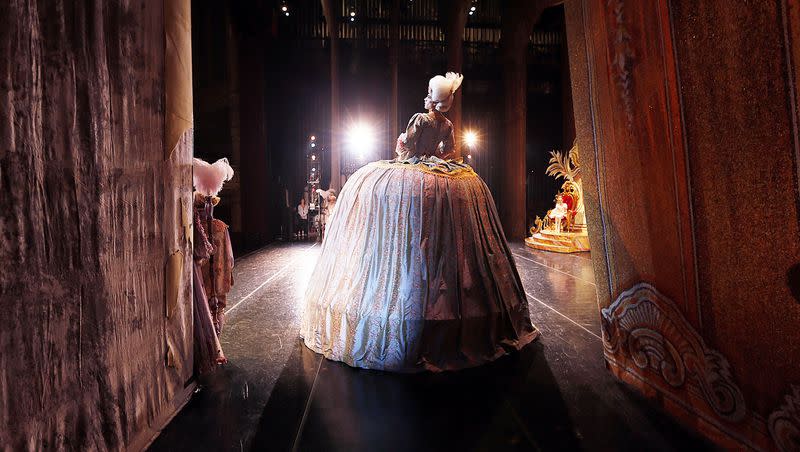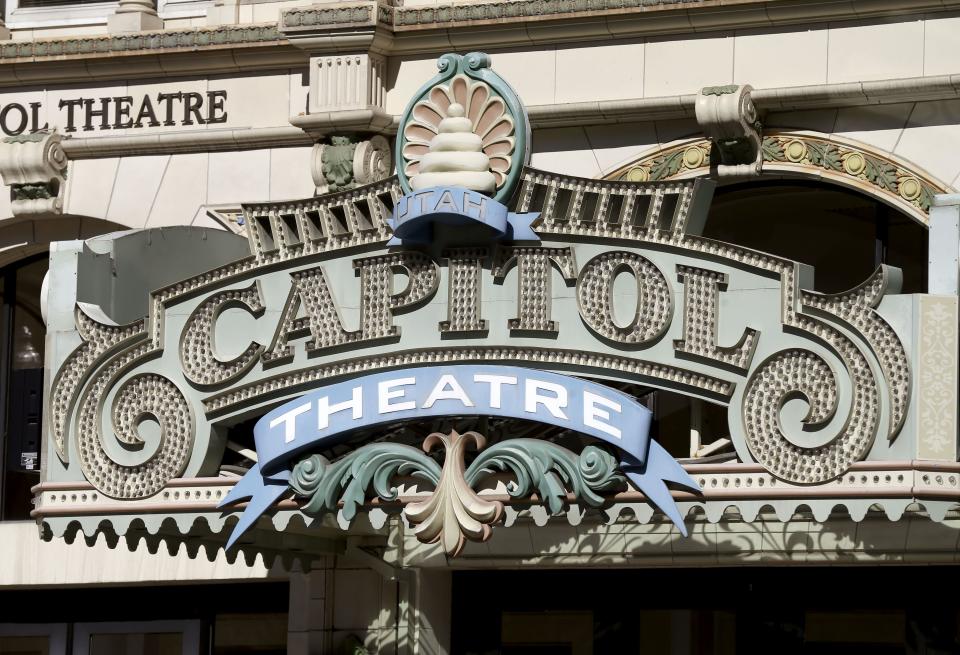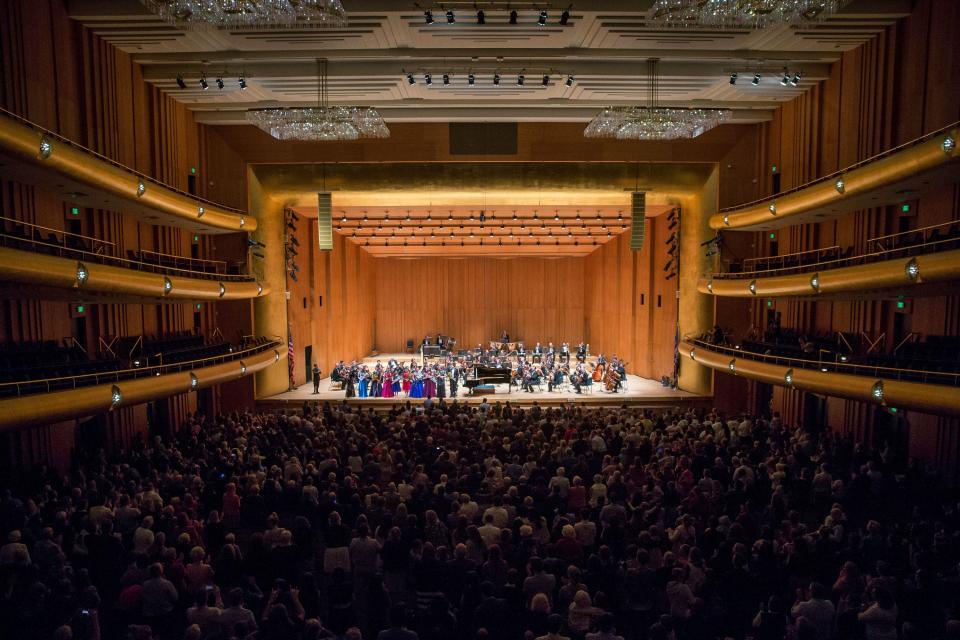Opinion: The forgotten story of how Salt Lake’s performing arts centers came to be

- Oops!Something went wrong.Please try again later.
As I was picking up some Utah Symphony tickets the other afternoon, the beautiful concert hall was deserted, so I took a little nostalgic walk around. Fifty-year-old memories flooded my mind, and it occurred to me that there are not many left that can tell the origin story of this hall — a story that few, even patrons of the arts, are aware of. It is, for me, a personal story, in a way a kind of miraculous story, and I love remembering it.
In 1974, Linda and I, who had started our family and my career as a political consultant in Washington, D.C., took a leave of absence to come to Utah for a year to plan and manage Salt Lake Mayor Jake Garn’s first U.S. Senate campaign. Jake started the campaign some 20 points behind his opponent, Congressman Wayne Owens, who was particularly prominent because of his recent TV visibility on the House Watergate committee. The Senate campaign was an uphill battle, but we closed the gap. Jake won the Senate seat, and our family returned to our home in McLean, Virginia, in time for Christmas.
Then, in February 1975, I was invited to lunch by Obert Tanner (founder of the O.C. Tanner company and chairman of Utah’s Bicentennial Commission) who was visiting Washington. We met in the restaurant of the Washington Hilton, and Tanner made me an interesting proposition. He said (paraphrasing) that he and Maurice Abravanel, the longtime Utah Symphony conductor, and others had been trying to find a way to build a new center for the performing arts in Salt Lake that would house the Utah Symphony and Ballet West and other arts groups. They wanted to make it happen as part of Utah’s Bicentennial Celebration — but the cost was prohibitive, and private fundraising had proven too difficult. So Tanner had decided that the only way to get it built was to hold a bond election. He had come to me because he was impressed with the upset victory I had engineered in the Garn Senate race and thought I was the person who could get this kind of bond election passed.
I remember saying something about how difficult I thought that might be — getting people in a hunting and fishing and sports-minded state to vote to increase their own taxes to pay for a high-brow symphony hall that they would probably never set foot in. But Obert Tanner was undeterred and, over the next week or so, convinced me that it was a truly worthy cause and that I should come back to Utah and manage the bond campaign. (The fact that Linda was a violinist and music teacher fit into his pitch.)
So, only months after returning to Washington, we moved again to Salt Lake and began our campaign for the bond election vote late that year — on Dec. 16, 1975. The strong support of the arts community, and of Utah’s wonderful and devoted arts patrons, was a given, but I knew there were simply not enough of them to win the vote, and the public opinion polls did not look good. Jack Gallivan, publisher of the Salt Lake Tribune and general chairman of the campaign committee, along with Wendell Ashton, Deseret News publisher, agreed that the odds were long against the bond election succeeding.
Related
An acoustical dream: Abravanel Hall celebrates its 25th anniversary
Looking for something to do? Visit these arts and entertainment venues in Salt Lake City
Optimistically, the committee hired a world renowned acoustician (a profession I didn’t know existed) named Cyril Harris to come from his New York office to advise us on the arts center we hoped to build on the corner of South Temple and West Temple. I remember Harris as a man of candor as well as expertise, and he told us, bluntly, that it would be a huge mistake to try to build a multipurpose hall. If you try to serve the symphony, the ballet and drama all in one hall, it will be a compromise, he said. A rectangular “shoebox” hall is best for the acoustics of symphonic music, and if you build a hall with a movable proscenium and deep, high stage needed for dance and drama you will lose the acoustics. “You need two separate halls,” he said.
In my mind, that made the difficult bond issue look completely impossible. I didn’t know how we could pass an election for one hall for the performing arts, let alone two.
But a couple of weeks later, a wonderfully serendipitous thing happened. I was on my way to the airport to go look at some other concert halls around the country and as I drove down 200 South, I noticed the old Capitol Theatre on my right. I couldn’t remember ever having been inside, and it was then a run-down, walled-over movie theater, a far cry from the live performance hall it had been built as decades earlier. On an impulse, remembering
Harris’ words that we needed “two halls,” I pulled into a parking space, bought a ticket, and went in to walk around and explore the old hall.

I was anything but an expert, but I could tell that, under all the wallboard, lowered ceilings, and paint, there was a classic old theater here, perhaps one with potential for restoration.
From that moment, we were on a new trajectory for possible election success. As I discussed it with Tanner and Gallivan and others, a new campaign plan took shape. We could build a dedicated new symphony hall for the orchestra, and restore the Capitol for the ballet and other dance and drama use. Ensuing cost estimates showed that we could actually build the simpler “shoebox” symphony hall and restore the old theater for less than the projected cost of one multipurpose performing arts center. We could sell this to the voting public as a two-for-the-price-of-one sale.
From there we picked up momentum, and our campaign volunteers (we were manning a phone bank of 40 or 50 phones, day and night, to find and turn out “our” voters) now consisted of musicians, dancers, actors and historic preservation advocates, each reaching out to their patrons, supporters and friends. We became formidable, and we knew that, while we might still be a minority, if we could turn out a higher percentage of our vote than that of our opponents, we could win.
Related
Find out how Utah’s smaller arts groups thrive in series ‘Beyond Abravanel Hall’
Utah’s Capitol Theatre finishes $33 million renovation, gets rid of seats — and possibly a ghost
And win we did, by the narrowest of margins. I will never forget that election night. The results came in slowly as we all gathered in the shabby lobby of the Capitol Theatre — all those who had worked so hard, from prima ballerinas to French horn players to structural historians. And when the TV stations announced that we had won, everyone was hugging one another, and giving emotional high-fives. At last, our renowned Utah Symphony would have its own state-of-the-art home, as would our exceptional Utah Ballet and other performing arts groups. And a marvelous and historic old building would be saved for future generations. The mental image I still see in my mind’s eye is Obert Tanner and Maurice Abravanel, two majestic, passionate, white-haired arts-patriarchs, embracing each other, tears rolling down their cheeks. A dream had come true.
Few if any cities of Salt Lake’s size have the quality and brilliance of our performing arts, and now they would have venues worthy of their exceptionalism.
My hope is that we will all appreciate those venues, and our arts heritage, more by knowing “the rest of the story.”
Personal postscript: Shortly after the arts bond election passed, Linda and I were called to be mission leaders for The Church of Jesus Christ of Latter-day Saints in London, so we didn’t get to witness the construction of Symphony Hall or the restoration of the Capitol Theatre. But we had the almost magical exhilaration of returning three years later to see both of those two works of art completely finished and in operation — their beauty exceeding our imagination and expectation. Tanner had gold-leafed all the beautiful accents and balconies of the new hall, frequently quoting his favorite Keats poem, “A thing of beauty is a joy forever.” Gallivan had seen (and led) the coming together of an arts-focused community coalition in a way that had never happened before. And Abravanel had, for the first time, conducted the Utah Symphony in a venue other than the “borrowed” Latter-day Saint Tabernacle.
Richard Eyre is a New York Times No. 1 bestselling author who, with his wife Linda, wrote a column in the Deseret News for 10 years and who still occasionally contributes to the editorial page.


